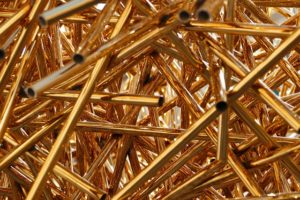Alloys are among the oldest and most valuable discoveries of mankind. They’ve helped expand our capacity for construction and served as the building block of innovation. For millennia, we’ve mastered the craft of creating alloys to meet the ever growing demand for superior materials and managed to succeed every time.
Two of our greatest creations are, arguably, brass and stainless steel. Packed with useful properties, they are staple materials for a vast range of applications, including construction, transportation, machine building, and plumbing. But which of them is better? Or is it necessary to compare? Let’s find out the truth about the “brass vs stainless steel” quandary.
Composition and Properties
The best way to differentiate between brass and stainless steel is to know their composition. Brass is an alloy of copper and zinc, while steel is an alloy of iron, carbon, and chromium. Just by their base metal, you can easily tell which has suitable properties for particular applications. For instance, in terms of corrosion resistance, iron pales in comparison to copper. In fact, iron is the metal that makes ferrous metals rust fast.
Simply put, brass is generally more corrosion-resistant than stainless steel. While the addition of chromium to steel makes a whole lot of difference to its ability to resist rust, it is still susceptible to corrosion at some degree.
When it comes to electrical and thermal conductivity, brass outmatches stainless steel by fifteen times. It also has a higher thermal expansion coefficient, which makes it perfect for applications that involve extremely high temperatures, including furnaces and engines.
In terms of manufacturing cost, there’s no significant difference between brass and steel, although steel is much more difficult to machine than brass. Brass, after all, is well-known for its machinability, which is why it is the metal of choice for applications that require small, precise metal pieces, so steel doesn’t stand a chance.
Stainless steel, on the contrary, has a higher resistance to petroleum products and many acids than brass, and it can be passivated in either citric or nitric acid solutions. Some grades of stainless steel are also superior to brass in more-aggressive marine environments such as fast-moving currents.
Where to Find Brass
Finding the right metal for your projects can be daunting, but if you go to the right supplier, it won’t be that hard. How do you find a good supplier then? Well, there are a few things you need to watch out for.
First, and most important, is the number of years the supplier has been established. After all, it makes more sense to trust someone who’s had many years of experience than someone who’s just starting. An experienced supplier has tackled virtually all kinds of material needs from all sorts of customers, so there’s a good chance they can meet your needs pretty easily.
Next, make sure that they specialize in copper products. This way, you can be sure of the quality of your brass supplies. Some of the country’s brass metal sheet suppliers, such as Rotax Metals, offer an immense selection of brass supplies. You won’t run out of choices unlike when you go to a supplier that offers a wide range of metals.



